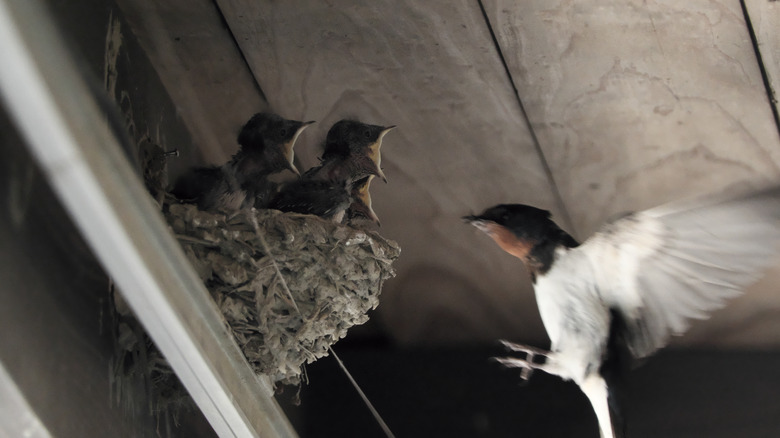Telltale Signs That Birds Are Living In Your Attic (& What To Do About It)
Many homeowners place birdbaths and birdhouses outside their homes in hopes of attracting some feathered friends to the garden. But the last thing you want is for them to move into your attic. In addition to making a big mess and causing damage, birds living in the top of your home can also make you, your family, and your pets sick. Signs that they might be living in your attic include weird noises, unpleasant smells, and even just an increased number of animals around your home in general. If they're roosting in the space, the best thing you can do is to call a professional right away to safely remove them. Once the infestation is gone, you can take preventative measures like sealing cracks and covering up vents to keep your attic bird-free.
If you suspect birds have taken up residence upstairs, avoid spending time in the area until they're safely removed by professionals. Their droppings and feathers can transmit harmful diseases, and even breathing in the contaminated air can cause illness. It's also important to avoid trying to catch and remove the birds in your attic by hand — this can harm them and is yet another way for disease to spread.
What to look for
There are a few giveaways that birds might be roosting in your attic. If you hear weird scratching, cooing, or flapping sounds coming from the space, you might have a problem. Additionally, they aren't exactly the cleanest critters. Bird droppings, feathers, chunks of insulation, and nesting materials are things they may leave behind. You might spot these messes near entryways to the attic or on the floor. Unpleasant smells may also accompany infestations.
When birds move inside someone's home or attic, they may bring other pests with them, like lice and mites. Lice and mites feed on these animals, and it's not uncommon for them to infest nesting areas. It is also not uncommon for these pests to spread and give you and your pets small, itchy red bites. If you're experiencing sudden respiratory problems, that may also be a sign of bird infestation. Dried bird droppings contain pathogens that can be picked up by the wind and spread throughout your home. Breathing in this contaminated air can cause respiratory problems, or even exacerbate any current conditions you have.
Attic damage from the exterior of your home may also indicate birds living there. A hole in the roof, for example, may be the pathway that they use to fly in and out of your abode. Unusual levels of bird activity around the exterior of your house could also suggest infestation.
What to do about an infestation
While it may be tempting to dive headfirst into removing birds from your attic yourself, you should contact a professional first. Not only can handling them cause harm to the animals and potentially make you sick, but it also might be illegal! Certain species of birds and their nests are protected by wildlife laws, and are illegal to move.
Once the birds are safely removed from your attic, there are steps you can take to keep them from coming back. First, you'll want to seal any holes or cracks that they might use to get into your home. Birds can also get inside through vents and chimneys, so use wire mesh or chicken wire to keep them out of those entrances. Another way to keep birds out of your attic is to make it an unpleasant place for them to be. Typically, they seek shelter in this space because it's dark, quiet, and warm — aka, the perfect place to nest! Installing strobe or motion sensor lights will likely make your attic less habitable to birds and might deter them from roosting there — they really don't like bright lights. If you don't mind a more unseemly approach, you can also install bird spikes around your attic and chimney to prevent them from nesting in or around your house.


